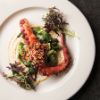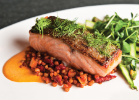Cover Story
The Codfather
For celebrated NYC chef Todd Mitgang, it all began in a dorm room at UB

Mitgang inside Crave Fishbar.
Story by Maria Fontoura | Photographs by John Emerson & Ashley Sears
Ask UB alumni outside Western New York to wax nostalgic on the cuisine of their college years, and most will go deep on the gut-busting joys of wings, charcoal-broiled foot-longs and beef on weck. For Todd Mitgang (BS ’02), it was all about Wegmans. As a freshman in the fall of 1998, Mitgang, who hails from Long Island, was grocery shopping for himself for the first time, and, to hear him describe it, the moment he set foot in this fluorescent-lit food emporium was an epiphany, like Dorothy reaching the Emerald City. “This was a superstore with ethnic aisles and beautiful produce and a real seafood market like I hadn’t seen before,” he says. “There was something so visual about it.” It was a culinary awakening that, combined with a devotion to the budding Food Network and the encouragement of some hungry college pals, spawned a future chef.
Today, Mitgang is co-owner and executive chef of two thriving New York City restaurants, both staples of their respective neighborhoods. With business partners Brian Owens and Jason Steinthal, he opened Crave Fishbar in Midtown East in 2012; three and a half years later, they brought an outpost to the Upper West Side. Not only has Crave won praise for its eclectic menu—rice-dusted calamari in a Thai miso sauce with Aleppo chile; paprika-roasted salmon with popped sorghum; fried chicken with Israeli couscous—but it also was the first Manhattan restaurant to pledge allegiance to the rigorous sustainability guidelines of the Monterey Bay Aquarium’s Seafood Watch program, meaning all of the seafood served is fished or farmed using eco-friendly methods.

Last year, the restaurant upped its progressive cred by becoming a Certified B Corporation (a sort of Hippocratic oath for businesses that amounts to a promise to do good in their communities). It’s a holistic approach to restaurateuring that speaks directly to Mitgang’s character. He has culinary bona fides, no doubt. But in a volatile industry notorious for attracting temperamental, hard-partying egomaniacs, Mitgang is a rarity: grounded, easygoing and clearly here to stay.
There is not much in Mitgang’s childhood to suggest he would become one of New York City’s more successful chefs. Like most kids in the ’80s (which is to say, long before the advent of “foodie” culture), he grew up eating home-cooked meals helped along by prepackaged grocery-store staples, such as Near East-brand rice pilaf and Marie’s Creamy Ranch dressing. A pasta salad of penne with jumbo shrimp coated in some kind of peanut-sesame-soy sauce passed for “Asian.” (He’s quick to note that he and his two sisters always asked for this exotic dish.) He didn’t spend much time in the kitchen, save for occasionally making himself omelets for breakfast, and he had a decidedly unadventurous palate.
“I can hear my mom saying it now: I was a ‘picky eater,’” he recalls. “As a good Jewish-American boy, I loved Chinese food, wonton soup. But if a scallion touched my broth, I’d push it away. Basil in my pasta? I couldn’t do it.”
Still, he picked up some fundamentals by osmosis. He praises his mother’s dexterity with proteins from lamb to pork and beef, her deft hand with powdered garlic and, most importantly, her skills with the broiler (“actually a fantastic technique, and great when you don’t want to make a mess”)—skills that provided the foundation for his foray into cooking in college.
Unlike most college bros in the throes of gastronomic independence, Mitgang and his friends eschewed greasy junk food. Former high school jocks who were still into working out, this crew would leave the gym and down Myoplex protein shakes, then head to the grocery store to see what they could rustle up for themselves that wouldn’t threaten their Mr. Universe physiques. Ten or so guys would each throw in five bucks “so we could eat something that was tasty and made us feel better,” Mitgang says.
When they got back to the dorms with their bounty, there was just one problem: Only one of them had even a passing knowledge of how to cook. “Somehow, growing up in my mom’s house, I had more technical skill than anybody else,” says Mitgang, still fit and trim at 36. “I knew how to broil. I knew how to make the rice pilaf. I at least felt comfortable with those basics.” After the guys transitioned into off-campus apartments with real kitchens and dining rooms, their post-workout meals evolved into full-fledged dinner parties, with Mitgang the unofficial head chef. He loved seeing people gather in the kitchen, watching him work, expressing amazement at some dish he’d improvised after catching an episode of Sara Moulton’s “Cooking Live” or Ming Tsai’s “East Meets West.” But he realized there was a deeper kind of fulfillment brewing, too.
“There was never a time where I was preparing something and thought, ‘I’d rather be doing something else,’” he says. “It was very relaxing. And I was learning. I would say, ‘I just saw an episode on knife skills, this is how you do this, and as long as I don’t cut my finger off, great!’ I liked that I was challenging myself.” A few Old World lessons courtesy of an Italian-American roommate’s mom expanded his repertoire even further. (“She taught me how to make sauce from scratch. I thought, ‘Wait a second … garlic, olive oil, crushed tomatoes, salt … that’s all you have to do?’”), and soon enough he was asking friends as they ate his food, “Would you pay for this?”

Raw oysters at Crave.
Mitgang entered New York City’s French Culinary Institute in June 2002, one month after graduating from UB; in less than two years, he’d go from off-campus dinner-party impresario to real-world sous-chef at a new restaurant, Kittichai, that would quickly become one of Manhattan’s hottest. Nominally Thai, the menu also drew influence from China, India and Southeast Asia. It was Mitgang’s first exposure to authentic cuisine from that part of the world; more than a decade later, its DNA is all over his menu at Crave, particularly in the restaurant’s signature lobster curry. Thanks to the fact that Kittichai was in a hotel—the trendy 60 Thompson in SoHo—which demanded it provide room service as well as feed two packed bars, it also seriously burned him out. But from burnout came inspiration.
“There was a lot to [the job at Kittichai],” Mitgang says. “So I started thinking about a simplified menu. I’d been creating a lot of crudos; that would always be a nightly special. And I loved it and had a lot of fun with it. At that point, at some of the nicer restaurants, you could get raw fish: crudos, sashimi. You could go to a billion Japanese restaurants and eat sushi. But where was the place that was doing something different? We hadn’t seen a lot of ceviche. That was an awesome concept.”
New York City agreed. With the help of a financier, Mitgang struck out on his own, found a tiny space on the east side of Manhattan and opened Crave Ceviche Bar in 2007 to rave reviews. Having a menu with such strict parameters—it was composed entirely of ceviche (raw fish cured with the application of some kind of acid)—“forced the creativity,” he says. Arctic char was doused in a champagne truffle broth. Sweet lobster was “cooked” in a Meyer lemon marinade. And every night, there was a line out the door. Mitgang was not yet 30 years old, and he was killing it in the toughest restaurant city in the world.
And then the unthinkable happened. On March 15, 2008, a sunny Saturday afternoon, a 200-foot construction crane collapsed onto the townhouse adjacent to Crave, killing four people. The four-story building that housed the restaurant suffered enough damage that its tenants were evicted, and Mitgang’s operation was shut down indefinitely. It was just seven months after Crave had opened, and right after they’d gotten their liquor license and completed an expansion that nearly doubled their size from 26 to 45 seats.
A protracted legal battle with the building’s landlord ensued. Mitgang and company were fighting to reopen in the same space; the landlord wanted to evict them, tear down the entire structure and rebuild. While the Crave team walked away with a settlement, it hardly felt like a victory. They were battle-worn, and it was the depth of the Great Recession—not an ideal time to open a restaurant. As they looked for a new space in the city, Mitgang secured some consulting gigs; in 2010, he helped open a taqueria, Cascabel, on the Upper East Side, and then a seafood-focused restaurant, South Edison, in Montauk, on the tip of Long Island. Then fate struck again: In 2011, a restaurant space became available at 945 Second Avenue, literally across the street from where Crave Ceviche Bar had stood at number 946.
The restaurant’s logo.
Though Ceviche Bar was clearly Mitgang’s first love, Fishbar is the relationship that’s built to last. The pair of restaurants keep him firing on all cylinders—managing a staff of 40-plus people, ordering product, creating dishes, writing menus, reviewing budgets, working the line, expediting, glad-handing regulars— which is exactly how he likes it. And as exhausting as it all sounds, Mitgang enjoys being in the kitchen so much that even after a day of being up to his eyeballs in yellowfin tuna and Norwegian cod, he’ll go home to Long Island and cook for his wife, Colleen, an anesthesiologist, and their two kids, Hugh, 4, and Eloise, 3. That is, unless Colleen feels like taking the reins.
“My wife grew up with food,” he says with pride. “She’s I-talian. Her grandparents owned a cheese shop in Brooklyn, and she’ll always tell stories about how they literally made everything from scratch. So she loves to eat, loves good food and happens to be a great cook. I’m always excited when she’s in the kitchen.”
No doubt, Mitgang is a family man—both at home and at work. For all the joy that cooking brings to his life, he says the part of his job that’s the most meaningful, where he feels most at home, is managing the staff. It is not a common refrain among chefs and may very well be the secret sauce that makes his restaurants so successful. “We’ve had very little turnover in the kitchen,” he says. “Being able to look at a whole group of people who have been with me for four, five years, or who have been with me through three different concepts, whom I’ve known for the last 10 years … that’s unbelievable.”
“Do I love making badass food?” he continues. “Of course. That’ll always be my wheelhouse. But a lot of my job is just trying to create a fun work environment. No matter what’s going on, I’m giving a lot of my energy. We’re smiling down in the kitchen, we’re playing music, trying to have fun and joke with each other. I mean, we could be working next to each other for 12 hours in a tiny space. So it’s just not really allowing people that negative spin. We’re cooking; this is what you signed up for.”
He claps his hands. “Let’s do it!”
A selection of dishes from Crave Fishbar:
.........................
Maria Fontoura is a writer and editor based in New York City.







